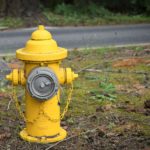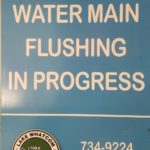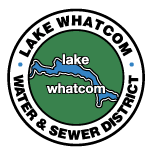Water Main Flushing
 Water main flushing is the process of cleaning or “scouring” the interior of water distribution mains (pipes) by sending a rapid flow of water through the mains. Distribution mains convey water to homes, businesses, and hydrants in your neighborhood. To perform this important preventative maintenance, our crews open the hydrants and release water.
Water main flushing is the process of cleaning or “scouring” the interior of water distribution mains (pipes) by sending a rapid flow of water through the mains. Distribution mains convey water to homes, businesses, and hydrants in your neighborhood. To perform this important preventative maintenance, our crews open the hydrants and release water.
Why do you flush the lines?
- Flushing helps maintain water quality. The water entering distribution mains is of very high quality; however, water quality can deteriorate in distribution mains if the mains are not properly managed.
- Flushing the lines removes sediments and mineral deposits that naturally build up on the inside walls of the pipes. As water flows at high velocities through the mains, encrustations, biofilm, and fine sediment are dislodged.
- Flushing can remove water from areas of the distribution system that have low water use, since the older water may no longer have the desired chorine residual. The infrastructure of the water distribution system is designed with “loops” and interconnected grids to keep water moving. Some areas may have dead ends where water can get caught and sit, and flushing helps to remove any water that can may be caught in those areas.
- Flushing allows us to verify proper operation of the hydrant and valves, and evaluate the available flow to the hydrant.
When does line flushing occur?
Water main flushing usually takes place in the spring and summer. For example, in 2019, the District’s first flushing period ran from May 13 to June 6. The District generally schedules multiple flushing periods with breaks in between.
Flushing generally occurs during the District field crew’s regular operating hours of 7:00 am to 5:30 pm, Monday through Thursday.
How long does flushing take?
A flushing period may be scheduled for a period of 3 weeks or more. During this time, crews will spend partial days flushing lines. The length of the flushing period and how long each section of pipe takes will vary depending on infrastructure and on other tasks that come up during that time.
What will I notice in my home or neighborhood during flushing?
 Before flushing begins, our crew will place a ‘Water Main Flushing in Progress’ sandwich board sign in your neighborhood. This sign indicates that some part of the area is being flushed. Signs may stay up for quite a while since flushing is routine maintenance, and sometimes gets bumped by more emergent work. Most individual customers are only directly affected for a few hours each as we flush past their property.
Before flushing begins, our crew will place a ‘Water Main Flushing in Progress’ sandwich board sign in your neighborhood. This sign indicates that some part of the area is being flushed. Signs may stay up for quite a while since flushing is routine maintenance, and sometimes gets bumped by more emergent work. Most individual customers are only directly affected for a few hours each as we flush past their property.
Sometimes during flushing, a small amount of sediment may get into your home’s plumbing. Remember, flushing is aimed at maintaining long-term water quality, but it could result in some short-term deterioration. You may notice a temporary discoloration of the water in your home. The discolored water is not harmful to human health or other household uses.
If this happens, please be patient and allow your cold water to run for a few minutes at full velocity. If you notice visible sediment in the water, you may want to remove the screens from your faucets to allow it to exit the pipes. During this time, you should avoid using hot water to prevent sediment accumulation in your hot water tank.
Very occasionally, air bubbles may form in the pipes during flushing. Don’t be alarmed if you notice the water from your tap sputtering or flowing irregularly. Running your tap will help to clear the air from your lines.
Does flushing fit with the District's conservation goals?
The amount of water used to flush a particular section of pipe depends on many factors, including the size of the main and the amount of accumulated sediment. Flushing is a necessary process to help keep our water mains clean and clear of sediment, which allows the District to provide excellent water quality, and increased pressure and flow.
Water is a limited resource, and the District is focused on quality and conservation. Our flushing program is monitored with the goal of using the least amount of water possible to still maintain delivery of high quality water to our customers.
